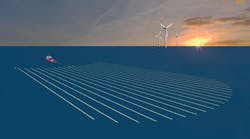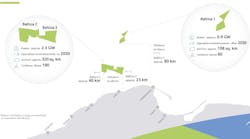Offshore staff
DUBLIN, Ireland– Providence Resources has provided an overview of its analysis of frontier exploration license (FEL) 2/14 in the southern Porcupine basin offshore southwest Ireland.
The license is in 2,500 m (8,202 ft) of water, 220 km (137 mi) from the west coast. Providence operates in partnership with Sosina Exploration.
After identifying the Druid prospect on the acreage last month, the company has continued evaluating Polarcus’ new 3D seismic reflection data.
Its most recent analysis has focused on the pre-Cretaceous section within FEL 2/14 which has confirmed the presence of a large, ultra-deep north-south orientated pre-Cretaceous structure (“Diablo Ridge”) that had been evident on the previous 2D long offset seismic reflection profiles.
The new data has improved imaging of the ridge, which exhibits around 120 sq km (46 sq mi) of closure at base Cretaceous level with the crest of the ridge.
Like the nearbyDunquin Ridge in FEL 3/04, the Diablo Ridge was previously interpreted to be of volcanic origin. However, the new data suggests it is instead a large rotated fault block with an internal reflectivity consistent with a Mesozoic sedimentary section.
Its crest exhibits a marked fluid escape feature which appears to be vertically connected to the overlying Drombeg and Druid prospects.
John O’Sullivan, the company’s technical director, said: “The internal seismic reflectivity suggests the potential for clastic reservoir development and whilst further work is required to understand the exploration potential of the ridge, we believe that its potential role in charging the overlying Drombeg and Druid prospects may be significant.
“It is notable that the Diablo Ridge lies paleogeographically on-trend with the recent Statoil-operated pre-Cretaceous oil discoveries on the Canadian conjugate margin in the Flemish Pass basin.”
07/17/2015




